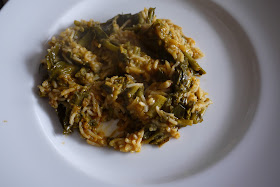Here is a simple and quick recipe that I often cook when I don't have time and I want to eat something warm. It is my own creation using Misr(Malka, pink lentils) and Brown Basmati rice. The recipe uses a pressure cooker to cut down on the cooking time. I know that this is an amazing meal because I typically don't feel hungry for at least six hours. In my personal experience, the higher the nutrition is in the food you eat, the greater the degree of satiety.
Nutrition Information:
- Total Protein: 36 grams (26 grams from Malka and 10 grams from Rice)
- Total Fiber: 35 grams
- Total Calories: about 700 calories.
Cost of the Meal: 70 cents; I hope McDonald Corporation goes to hell.
This is a complete meal because the rice adds the two essential amino acids that are missing in Malka.
Ingredients:
- One tablespoon olive oil(regular) or sunflower oil.
- 1/2 cup Misr, Malka, or Pink Lentils(100 grams)
- 1/2 cup Brown Basmati rice(100 grams)
- Two teaspoons of Berbere.
- 1/2 teaspoon korarima(optional).
- 1/2 teaspoon salt, or adjust according to taste.
- 2 Cups of water.
Modifications:
- One can also use white basmati rice, or any other white rice. Reduce the cooking time to 5 minutes instead of 10 minutes for brown basmati rice. Also, raise the amount of water to 3 cups instead of 2 cups, and increase the amount of berbere to 3 teaspoons.
- Add your favorite greens or vegetables. If you plan to add vegetables then use white rice because the vegetables will be destroyed if cooked for too long. The pictures below show some variations using vegetables.

Mysterious greens from farmers' market







I love your recipes and appreciate the Indian references, since that is the food I am most familiar with. I would like to know if you make your own Niter Kibe?
ReplyDeleteAlso, where do you buy your spices? Particularly the berbere? I wonder if Ethiopians are as loyal to spice brands as Indians...Anything like a Everest vs MDH brand? Or do you buy it in a specialty shop?
I actually don't know how to make Niter Kibe. I do have a sense of how its done. My understanding is that all of the Ethiopian stores import the butter from Ethiopia, then they melt the butter and add the spices(sage, thyme, cardamom(elaichi), etc.) and cook. To me it is like Indian ghee, and has the same texture. It is very intense in flavor, partly because it is based on milk from cows in Ethiopia, who are probably eating good stuff.
DeleteThere are three places on Telegraph Avenue in Oakland, there is the Yagerbeti Market next to Koreana Plaza(I believe 24th and Telegraph), then there is the Zion Market(approx. 30th and Telegraph), and finally there is closer to 40th and Broadway(Zahara??). I like Yagerbeti, which seems to be the favorite of the Ethiopians, and is also reasonably priced. The berbere I buy from Yagerbeti is in a plastic bag, and has been repackaged by the store owners. They are probably buying big sacks from Ethiopia and reappportioning them to smaller sizes. I have only seen Ethiopians in the store, so far it seems I am the only Indian who has ventured there. Couple of times, they have asked me, "Are you Habisha?", I laughed.
Finally none of these shops are fancy and they speak very little English, but what they sell is of high quality. I would say start with Yagerbeti, that is the most comprehensive of the three stores I mentioned. And finally, there is some kind of a bulk distributor on Adeline in West Oakland, I haven't ventured there but if you need to start feeding Ethiopian food to a family of five, that is where I would probably head to buy my 50 lbs of pink lentils.
Cheers
I am absolutely amazed at how terrific the stuff is on this site. I have saved this webpage
ReplyDeletelong grain brown rice
Excellent read, I just passed this into a colleague who was doing a little research on that. And he actually bought me lunch because I found it for him smile So let me rephrase that.
ReplyDeleteorgainic arborio rice
Useful information shared.. I got good information to read this article, thanks for giving us nice info. Fantastic walk-through. I appreciate this post.
ReplyDeletebasmati rice recepie
Great work buddy, keep it up
ReplyDeletelong grain rice
This comment has been removed by the author.
ReplyDeleteIt is useful and get the full of information here student making a best websites and that full of information here.
ReplyDeleteorganic
This comment has been removed by the author.
ReplyDeleteThis is really very impressive guide of valve selection which can be very helpful for many industry people. Thanks for sharing this valve selection tips.
ReplyDeletehow to cook long grain rice
Really cool post, highly informative and professionally written..Good Job
ReplyDeleteorganic white rice
Well, it’s a nice one, I have been looking for. Thanks for sharing such informative stuff.
ReplyDeletechopped dates
I am very enjoyed for this blog. Its an informative topic. It help me very much to solve some problems. Its opportunity are so fantastic and working style so speedy. I think it may be help all of you. Thanks.Delicious rice
ReplyDeleteIs Basmati rice healthier than jasmine rice? Both Jasmine and Basmati rice are low in fat and will give you a small protein boost. However, basmati is a healthier choice for diabetics, as it has a lower glycemic index than high quality Pakistani rice (59 to jasmine's 89). Both of these varieties are usually sold 'white'.
ReplyDelete